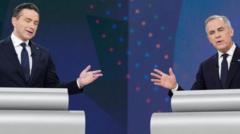In a televised face-off, the leaders of Canada's four main political parties gathered for their final debate ahead of this month's general election. The high-stakes event didn't just capture attention for the leaders' exchanges, but also for the influence of U.S. President Donald Trump looming in the background.
Liberal leader Mark Carney, previously leading in the polls, faced intense questioning from Conservative Pierre Poilievre, NDP’s Jagmeet Singh, and Bloc Québécois’s Yves-François Blanchet. A central theme was Canada's ongoing trade tensions with the U.S., alongside discussions on affordability, crime, and environmental concerns. Here are the five major takeaways from the debate:
**1. Haunting Shadows of Trudeau:**
Carney often found his predecessor Justin Trudeau’s contentious legacy highlighted by opponents. Poilievre criticized the “lost Liberal decade,” raising issues such as housing affordability, questioning Carney's ability to differ from Trudeau. In defense, Carney emphasized his distinct leadership style, stating, “I am a very different person than Justin Trudeau.”
**2. Taming Trump’s Tariffs:**
The debate turned to how the candidates would address Trump’s tariffs on goods from Canada. Discarding the aggressive “dollar-for-dollar” approach, Carney noted the U.S. economy dwarfs Canada's. He hinted at more strategic, targeted tariffs aimed at creating the least harm for Canada while applying pressure on the U.S.
**3. Policy Details Matter:**
Discussing broader issues, the leaders presented differing visions for Canada’s future. Poilievre pitched low taxes and a smaller government, while Singh advocated for enhanced social programs. Carney maintained a centrist view, suggesting government should play a catalytic role during crises, and Blanchet focused on protecting Quebec’s unique identity.
**4. Survival of Smaller Parties:**
As the election nears, smaller parties, like the NDP and Bloc Québécois, are feeling the pressure, with polls indicating a decline in support. Singh actively worked to make his party’s voice distinct in an effort to draw in left-leaning voters, while Blanchet sought relevance by addressing Quebec-specific issues amidst looming seat losses.
**5. Civility in Political Discourse:**
Despite interruptions and challenging exchanges, the tone of the debate was notably civil. Carney demonstrated this when he opted for politeness after a heated rebuttal, reflecting a more respectful atmosphere compared to recent U.S. debates, signaling a shift towards constructive discourse in Canadian politics.
The debate reflects not just the leaders’ platforms, but also an evolving narrative defining modern Canadian politics as voters gear up for the polls.
Liberal leader Mark Carney, previously leading in the polls, faced intense questioning from Conservative Pierre Poilievre, NDP’s Jagmeet Singh, and Bloc Québécois’s Yves-François Blanchet. A central theme was Canada's ongoing trade tensions with the U.S., alongside discussions on affordability, crime, and environmental concerns. Here are the five major takeaways from the debate:
**1. Haunting Shadows of Trudeau:**
Carney often found his predecessor Justin Trudeau’s contentious legacy highlighted by opponents. Poilievre criticized the “lost Liberal decade,” raising issues such as housing affordability, questioning Carney's ability to differ from Trudeau. In defense, Carney emphasized his distinct leadership style, stating, “I am a very different person than Justin Trudeau.”
**2. Taming Trump’s Tariffs:**
The debate turned to how the candidates would address Trump’s tariffs on goods from Canada. Discarding the aggressive “dollar-for-dollar” approach, Carney noted the U.S. economy dwarfs Canada's. He hinted at more strategic, targeted tariffs aimed at creating the least harm for Canada while applying pressure on the U.S.
**3. Policy Details Matter:**
Discussing broader issues, the leaders presented differing visions for Canada’s future. Poilievre pitched low taxes and a smaller government, while Singh advocated for enhanced social programs. Carney maintained a centrist view, suggesting government should play a catalytic role during crises, and Blanchet focused on protecting Quebec’s unique identity.
**4. Survival of Smaller Parties:**
As the election nears, smaller parties, like the NDP and Bloc Québécois, are feeling the pressure, with polls indicating a decline in support. Singh actively worked to make his party’s voice distinct in an effort to draw in left-leaning voters, while Blanchet sought relevance by addressing Quebec-specific issues amidst looming seat losses.
**5. Civility in Political Discourse:**
Despite interruptions and challenging exchanges, the tone of the debate was notably civil. Carney demonstrated this when he opted for politeness after a heated rebuttal, reflecting a more respectful atmosphere compared to recent U.S. debates, signaling a shift towards constructive discourse in Canadian politics.
The debate reflects not just the leaders’ platforms, but also an evolving narrative defining modern Canadian politics as voters gear up for the polls.



















